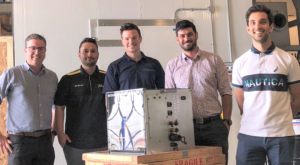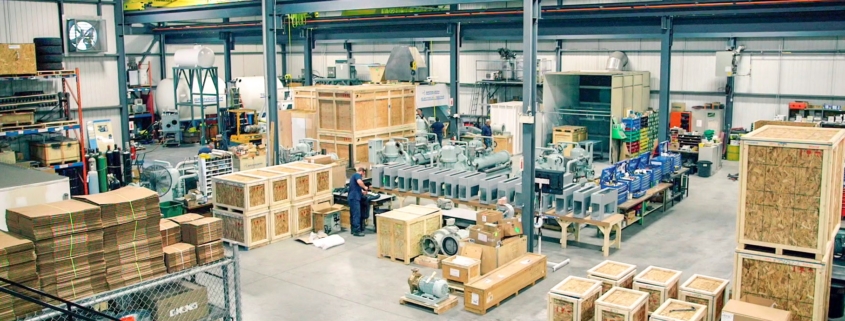Providing an integrated HVAC-R approach
This is a very exciting time to be involved in the naval shipbuilding industry with major shipbuilding programs kicking off in Canada. These programs not only provide vital equipment for the Canadian Navy, they also provide key Government strategies to build modern innovative shipbuilding infrastructures, which BRONSWERK Group is thrilled to contribute to.
As a global leading provider, BRONSWERK brings complete Heating, Ventilation, Air Conditioning and Refrigeration Solutions (HVAC-R) for the military, merchant marine and offshore industries. BRONSWERK has introduced new products to the market and its R&D program has rendered solutions that can be used in many systems and across many different applications, from frigates, support ships and research vessels to submarines.
BRONSWERK has embraced commonality throughout their solutions. When asked how does BRONSWERK apply commonality in HVAC&R applications, Francis Fontaine, BRONSWERK Group’s CEO, said “We want to allow shipyards, architects, installers, endusers and maintainers to get the best value from HVAC&R systems by taking advantage of the commonality our complete solutions offer: from design to commissioning and through-life support.”
THE VALUE OF A COMMON DESIGN
One way commonality can be implemented is at the system level. This is something BRONSWERK tries to apply as much as possible by using common design strategies such as proven stairway ventilation approach, Galley HVAC design and Machinery spaces air distribution. Using the same successful design solutions on several platforms optimizes the performance of the ship’s system and minimizes cost, design effort and risk.
SIMPLIFIED USER EXPERIENCE
BRONSWERK not only addresses commonality through systems, they also apply it from the equipment perspective, with a minimum number of variations in equipment selections.
As HVAC equipment continues its evolution and incorporates smart controls within, their human machine interfaces (HMIs) are the point at which the user operates and monitors their function. By offering all equipment with the same style of intuitive graphic touch sensitive interface, the similarity between equipment allows the crew members to naturally transition from operating one piece of equipment to another with minimum training requirement. Every BRONSWERK control panel, Air Handling Unit, Chiller, etc., have been designed to offer the same user experience eliminating potential issues and confusion.
The equipment commonality streamlines the training required to qualify the crews and the maintainers aboard ships. By having the same equipment platforms in different vessels, users trained to operate the equipment on one vessel are automatically pre-qualified to operate similar equipment on other vessels. Training maintainers is also a lot more effective and since they concentrate on fewer equipment variations, they can better understand the degradation patterns and offer better preventive maintenance.
Bringing the commonality to the equipment level will generate a positive impact on information management such as ILS (Integrated Logistics Support). It will significantly reduce the cost of development as information packages can be used from one platform to another, saving thousands of engineering hours while offering the best value to the end-users.

CUBE is a quick-connect, plug and play, water cooled condensing unit for marine applications.
INVENTORY MANAGEMENT & PREDICTIVE MAINTENANCE
As HVAC-R equipment gets smarter, they are able to adapt to more operating conditions than before. It is then possible, for example, to use the same Fan Coil Unit across the ship, despite the varying demands for each compartment. The same set of spares can be used to support all the Fan Coil Units onboard. This simplifies the use of spares both onboard and ashore. An added bonus of commonality is the purchasing power it brings to procurement departments as they negotiate larger orders with fewer vendors, offering the best value to the end-users.
Common platforms not only reduce the risk of maintenance mistakes they also permit predictive maintenance. As the maintainers gather performance data from a larger sample of units throughout the fleet, many preventive maintenance tasks can be replaced with evidence based predictive activities. By focusing resources where they have a greater impact on the system and equipment reliability, the risk of failures is reduced, and down time of the system is minimized.
INVESTING IN RESEARCH AND DEVELOPMENT
One of BRONSWERK’S success stories is the development of the patented CUBE solution for domestic refrigeration. This is the ultimate example of equipment commonality onboard a vessel. A CUBE is a quick-connect, plug and play, water cooled condensing unit for marine applications. It is extremely compact (18”x18”x18”), hence the CUBE name. It can be carried by two people through existing openings onboard the ship. The CUBE can maintain a refrigerated space at any temperature from -20°C to 8°C allowing unprecedented flexibility in food storage onboard ships. Since the CUBE has a universal design, a spare CUBE can serve as backup to any other operating CUBES. Easy to install, the quick-connects allow the users to replace a unit in just a few minutes and they can send a defective unit out for repairs eliminating the need for an onboard refrigeration mechanic. In an industry where security clearance is a requirement, not having to bring mechanics onboard is a considerable advantage.
Each CUBE serves one-unit cooler, and for larger spaces where more cooling capacity is needed, more CUBES can be installed. CUBES are easily installed simply by sliding them in a CUBE rack where quick connections for water, refrigerant, controls and power are made via plug assemblies and quick selfisolating connectors. Spare CUBES would be available onboard and ashore, becoming the smallest replaceable component onboard for refrigeration systems.
When asked what’s the great advantage of using the CUBE, Mr. Fontaine said “As the CUBE maximizes commonality, it nearly removes maintenance activities onboard and allows for incredible operational flexibility.”
This breadth of experience has enabled BRONSWERK to build a knowledge-based company whose service offering includes system design and Shock/EMI qualified OEM equipment for surface and sub surface combatants. BRONSWERK invests heavily locally in its people, plants and sub-suppliers to create an integrated support system not only to deliver the ships, but to ensure that maintenance, upgrades and through life support capabilities are developed in-country.
One of the primary objectives of the Canadian National Shipbuilding Strategy is to promote the Canadian Marine Industry. BRONSWERK Marine is already one success story of this program. As main partner for the NSS ships, including Arctic Offshore Patrol Ships (AOPS), Offshore Fisheries Science Vessel (OFSV), Offshore Oceanographic Science Vessel (OOSV) and Joint Support Ship (JSS), BRONSWERK has developed technologies that are used to implement commonality across these vessels and that has enabled them to lead the industry generating many export opportunities. BRONSWERK is now one of the main Global Leaders in Marine HVAC&R.




